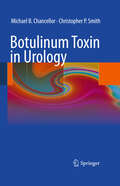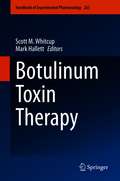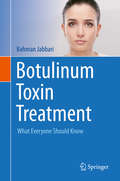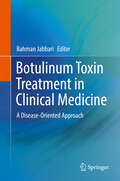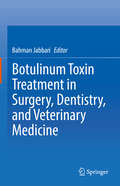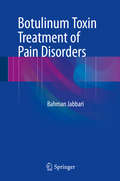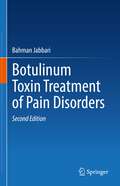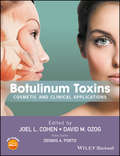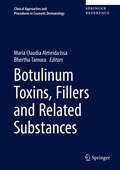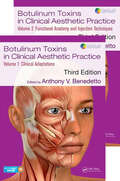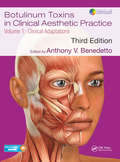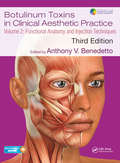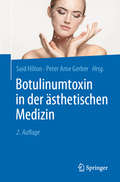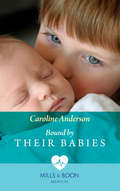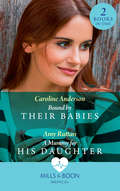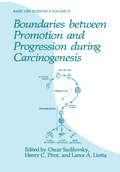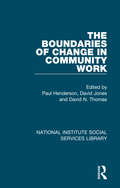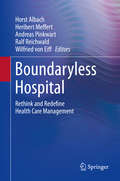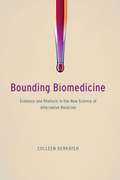- Table View
- List View
Botulinum Toxin in Urology
by Michael B. Chancellor Christopher P. SmithBladder injection of onabotulinumtoxinA for the treatment of urinary incontinence due to neurogenic detrusor overactivity has recently been approved by regulatory agencies in several EU countries and by the FDA in the United States. This is the first book to focus on the practical application of botulinum toxin (BoNT) in the genitourinary tract. It covers in detail applications of BoNT in the bladder and the prostate and pelvic floor, with reviews of the latest clinical series and techniques in both adults and children. Appendices containing easy-to-read instructions for patients undergoing bladder and prostate BoNT injections are included, in addition to procedural guidelines for nursing staff. The book is written in a concise, clinically relevant style by two leading pioneers in the field, who were the first to undertake comprehensive basic research into the mechanisms underlying the efficacy and potential uses of BoNT within the lower urinary tract.
Botulinum Toxin Therapy (Handbook of Experimental Pharmacology #263)
by Scott M. Whitcup Mark HallettIn a rapidly progressing field, Botulinum Toxin Therapy provides both clinicians and basic researchers with the latest science on the structure and function of botulinum toxins and the use of these toxins to treat a wide variety of diseases. Part 1 of the book reviews the basic science of botulinum toxins including advances in our understanding of the molecular structure and mechanism of action of botulinum toxins. This section also discusses the manufacturing and formulation of botulinum toxins for clinical use and the development of novel therapeutic toxins for the future. Part 2 reviews the use of botulinum toxins in clinical practice. It discusses the clinical pharmacology of botulinum toxin drugs and their use in a wide variety of clinical conditions including headache, spasticity, pain, disorders of the genitourinary and gastrointestinal tract, strabismus, and medical aesthetics.
Botulinum Toxin Treatment: What Everyone Should Know
by Bahman JabbariVery few therapeutic agents in clinical medicine have found indication for so many clinical conditions, and in such a short time as did botulinum neurotoxins (Botox and others). Chronic migraine, bladder dysfunction , dystonia, hemifacial spasm , blepharospasm , drooling, excessive sweating and spasticity are all approved by FDA and many other indications are in the near horizon . The aesthetic/cosmetic use of Botox and other BoNTs already has a huge market worldwide. Stroke, Multiple sclerosis, Parkinson’s disease, Cerebral palsy as well as brain and spinal injury are among clinical conditions in which some of patients’ major symptoms can respond to botulinum toxin therapy Several books have been written on the subject of Botox and other neurotoxins for treatment of medical disorders ( including two books by Jabbari both published by Springer 2015 & 2017). However, despite the huge interest and enthusiasm of the public to learn more about Botox and other toxins, there is currently no book in the market on this subject which is specifically designed to inform and educate the public on botulinum toxin therapy. Botulinum Toxin Treatment explains and discusses in simple language the structure and function of botulinum toxin and other neurotoxins as well as the rational for its utility in different disease conditions. Safety, factors affecting efficacy and duration of action, as well as cost and insurance issues are also addressed.
Botulinum Toxin Treatment in Clinical Medicine: A Disease-Oriented Approach
by Bahman JabbariThis book provides BoNT treatment menus for symptom-oriented therapy in 14 different disease categories.Each chapter starts with a brief description of the disease and its current treatment followed by an evidenced-based upon the published assertions of the Therapeutic Subcommittee of the American Academy of Neurology. Each chapter includes case histories from editor’s vast experience of over 25 years with BoNT therapy and description of injection techniques enhanced by illustrative figures. Botulinum Toxin Treatment in Clinical Medicine includes an additional introductory chapter that discusses molecular structure, mechanism of action, toxin serotypes, immunogenicity and safety issues. Meanwhile, a concluding chapter provides information on potential future application of these toxins’ for treating symptoms of other specific diseases.
Botulinum Toxin Treatment in Surgery, Dentistry, and Veterinary Medicine
by Bahman JabbariAll books on the market which have been written on the subject of botulinum toxin therapy focus on treatment of hyperactive movement disorders, autonomic dysfunction (bladder, sweat and salivary glands) and some pain indications (migraine). Reference to pre-or post -surgical indications are brief and often out-dated. No book has information on dentistry or veterinary medicine. This book provides up-to-date information on botulinum toxin therapy in surgical fields. It is also the only book in the market that provides information on botulinum toxin therapy in dentistry and veterinary medicine, furnishing the latest information. Botulinum Toxin Treatment in Surgery, Dentistry, and Veterinary Medicine appeals to many disciplines including surgery, dentistry and veterinary medicines well as appealing to neurologists and internists.
Botulinum Toxin Treatment of Pain Disorders
by Bahman JabbariThis book provides an authoritative overview of botulinum neurotoxin (BoNT) treatment menus for 14 pain categories with an evidence based literature review on each pain disorder, illustrative figures along with brief video clips showing the techniques and patient interviews. Introductory chapters cover basic information about the mechanism, function and the analgesic effects of the BoNTs based on the data derived from animal studies. Clinical chapters define pain in conditions such as post-herpetic and post-traumatic neuralgias, plantar fasciitis, low back pain, post-surgical pain syndromes and migraine in detail, provide discussion of current modes of treatment and updated information on BoNT therapy. Each chapter also includes illustrative case histories.Botulinum Toxin Treatment of Pain Disorders will prove an invaluable resource for clinicians and researchers involved in the treatment of pain disorders including neurologists, pain medicine specialists, anesthesiologists, internists, those conducting research in pharmacology and toxicology as well as students in these areas.
Botulinum Toxin Treatment of Pain Disorders
by Bahman JabbariThis book provides an authoritative overview of botulinum neurotoxin (BoNT) treatment menus for 16 pain categories with an evidence-based literature review on each pain disorder, illustrative figures showing anatomy and techniquesIntroductory chapters cover basic information about the mechanism, function and the analgesic effects of the BoNTs based on the data derived from animal studies. Clinical chapters define pain in conditions such as post-herpetic and post-traumatic neuralgias, plantar fasciitis, low back pain, post-surgical pain syndromes and migraine in detail, provide discussion of current modes of treatment and updated information on BoNT therapy. Each chapter also includes illustrative case histories. The new edition is updated with all the new findings since the explosion in research and literature since 2015. New chapters on the history and pain in dentistry round out the update.Botulinum Toxin Treatment of Pain Disorders provides an invaluable resource for clinicians and researchers involved in the treatment of pain disorders including neurologists, pain medicine specialists, anesthesiologists, internists, those conducting research in pharmacology and toxicology as well as students in these areas.
Botulinum Toxins: Cosmetic and Clinical Applications
by Joel L. CohenBotulinum Toxins: Cosmetic and Clinical Applications provides a comprehensive and in-depth review of the use of botulinum toxin for aesthetic procedures and medical applications as a stand-alone treatment and as part of combination therapy. Now a mainstay of cosmetic dermatologic practice, the range of available toxins and their varied applications has grown considerably in recent years requiring the practitioner to carefully consider what approach best suits the needs of their patient. This new book, written by international expert authors, provides guidance to help you refine your technique, add new procedures to your practice, and provide optimal results. This book: Offers guidance on best-practice approaches with botulinum toxin, helping create cutting edge, tailored treatment plans for each patient Benefits from a wealth of color images, procedural videos, and expert tips and tricks Takes a region oriented approach, providing guidance on treatment of the; glabella, forehead, periocular and perioral areas, and contouring of the lower face and lower leg and calf, and neck rejuvenation Contains a thorough review of non-cosmetic treatments such as correction of facial asymmetry, and treatment of axillary hyperhidrosis, plus palm, sole, and craniofacial hyperhidrosis Covers exciting new topics, such as future injectables, topical botulinum toxin, and facial contouring including treatment for benign masseter hypertrophy Discusses combination therapy of botulinum toxin with other non-surgical procedures such as hyaluronic acid (HA) or filler substances, light and laser sources, and other energy-based therapies Includes considerations for darker skin types Offer your patients the best care, stay on top of cutting edge techniques, and avoid pitfalls with coverage of practical tips and real cases. Botulinum Toxins in Dermatology: Cosmetic and Clinical Applications provides best-practice guidance on the contemporary use of botulinum toxin in isolation and in combination.
Botulinum Toxins: Cosmetic and Clinical Applications
by Joel L. Cohen David M. Ozog Dennis A. PortoBotulinum Toxins: Cosmetic and Clinical Applications provides a comprehensive and in-depth review of the use of botulinum toxin for aesthetic procedures and medical applications as a stand-alone treatment and as part of combination therapy. Now a mainstay of cosmetic dermatologic practice, the range of available toxins and their varied applications has grown considerably in recent years requiring the practitioner to carefully consider what approach best suits the needs of their patient. This new book, written by international expert authors, provides guidance to help you refine your technique, add new procedures to your practice, and provide optimal results. This book: Offers guidance on best-practice approaches with botulinum toxin, helping create cutting edge, tailored treatment plans for each patient Benefits from a wealth of color images, procedural videos, and expert tips and tricks Takes a region oriented approach, providing guidance on treatment of the; glabella, forehead, periocular and perioral areas, and contouring of the lower face and lower leg and calf, and neck rejuvenation Contains a thorough review of non-cosmetic treatments such as correction of facial asymmetry, and treatment of axillary hyperhidrosis, plus palm, sole, and craniofacial hyperhidrosis Covers exciting new topics, such as future injectables, topical botulinum toxin, and facial contouring including treatment for benign masseter hypertrophy Discusses combination therapy of botulinum toxin with other non-surgical procedures such as hyaluronic acid (HA) or filler substances, light and laser sources, and other energy-based therapies Includes considerations for darker skin types Offer your patients the best care, stay on top of cutting edge techniques, and avoid pitfalls with coverage of practical tips and real cases. Botulinum Toxins in Dermatology: Cosmetic and Clinical Applications provides best-practice guidance on the contemporary use of botulinum toxin in isolation and in combination.
Botulinum Toxins, Fillers and Related Substances (Clinical Approaches And Procedures In Cosmetic Dermatology Ser. #4)
by Maria Claudia Almeida Issa Bhertha TamuraBotulinum Toxins in Clinical Aesthetic Practice 3E: Two Volume Set
by Anthony V. BenedettoThis bestselling guide to the complexities of botulinum toxins has now been extensively revised, updated, and expanded. Now in two volumes, Volume 1 examines clinical adaptations in the toxins in use today, use with other injectables, use for other parts of the body and other indications, and legal aspects, while Volume 2 documents in detail the functional anatomy and injection techniques for the face, neck, and upper chest. No practitioner of aesthetic medicine will want to be without this comprehensive and authoritative guide from the international experts.
Botulinum Toxins in Clinical Aesthetic Practice 3E, Volume One: Clinical Adaptations (Series in Cosmetic and Laser Therapy)
by Anthony V. BenedettoThis bestselling guide to the complexities of botulinum toxins has now been extensively revised, updated, and expanded. Now in two volumes, Volume 1 examines clinical adaptations in the toxins in use today, use with other injectables, use for other parts of the body and other indications, and legal aspects, while Volume 2 documents in detail the functional anatomy and injection techniques for the face, neck, and upper chest. No practitioner of aesthetic medicine will want to be without this comprehensive and authoritative guide from the international experts.
Botulinum Toxins in Clinical Aesthetic Practice 3E, Volume One: Clinical Adaptations (Series in Cosmetic and Laser Therapy)
by Anthony V. BenedettoThis bestselling guide to the complexities of botulinum toxins has now been extensively revised, updated, and expanded. Now in two volumes, Volume 1 examines clinical adaptations in the toxins in use today, use with other injectables, use for other parts of the body and other indications, and legal aspects, while Volume 2 documents in detail the functional anatomy and injection techniques for the face, neck, and upper chest. No practitioner of aesthetic medicine will want to be without this comprehensive and authoritative guide from the international experts.
Botulinum Toxins in Clinical Aesthetic Practice 3E, Volume Two: Functional Anatomy and Injection Techniques (Series in Cosmetic and Laser Therapy)
by Anthony V. BenedettoThis bestselling guide to the complexities of botulinum toxins has now been extensively revised, updated, and expanded. Now in two volumes, Volume 1 examines clinical adaptations in the toxins in use today, use with other injectables, use for other parts of the body and other indications, and legal aspects, while Volume 2 documents in detail the functional anatomy and injection techniques for the face, neck, and upper chest. No practitioner of aesthetic medicine will want to be without this comprehensive and authoritative guide from the international experts.
Botulinum Toxins in Clinical Aesthetic Practice 3E, Volume Two: Functional Anatomy and Injection Techniques (Series in Cosmetic and Laser Therapy)
by Anthony V. BenedettoThis bestselling guide to the complexities of botulinum toxins has now been extensively revised, updated, and expanded. Now in two volumes, Volume 1 examines clinical adaptations in the toxins in use today, use with other injectables, use for other parts of the body and other indications, and legal aspects, while Volume 2 documents in detail the functional anatomy and injection techniques for the face, neck, and upper chest. No practitioner of aesthetic medicine will want to be without this comprehensive and authoritative guide from the international experts.
Botulinumtoxin in der ästhetischen Medizin
by Said Hilton Peter Arne GerberBotulinumtoxin gilt zu Recht als das Synonym für die Schönheitsmedizin. Seit Jahren stehen Botox-Behandlungen noch vor Fillerinjektionen oder invasiven Eingriffen (Lidkorrekturen, Fettabsaugungen, Brustvergrößerungen) an der Spitze der am häufigsten durchgeführten Behandlungen und die Nachfrage nimmt weiterhin zu. Dies liegt nicht zuletzt daran, dass die Ergebnisse immer besser werden, da behandelnde Ärzte immer erstklassiger ausgebildet sind und durch die mittlerweile jahrelange Anwendung auch einen größeren Erfahrungshorizont im Hinblick auf schwierigere Fälle aufweisen. Gleichsam sinkt die Angst der Patienten vor einer Behandlung mit dem sogenannten „Nervengift“. Dieses Buch vermittelt Fachwissen aus Wissenschaft und 20 Jahren Erfahrung in der ästhetischen Botox-Anwendung. Neben der detaillierten Darstellung von zugrundeliegender Anatomie, Injektionsschemata, Dosierung und Nebenwirkungsmanagement, finden sich auch viele Tipps und Tricks zu allen praxisrelevanten Aspekten der ästhetischen Botox-Anwendung, wie rechtlichen, organisatorischen und wirtschaftlichen Fragen, oder auch Patientenführung und –bindung.
Bound By Their Babies: Bound By Their Babies (yoxburgh Park Hospital) / A Mummy For His Daughter (Yoxburgh Park Hospital #1000)
by Caroline AndersonBest friends, single parents…
Bound By Their Babies: Bound By Their Babies (yoxburgh Park Hospital) / A Mummy For His Daughter (Mills And Boon Medical Ser.)
by Caroline Anderson Amy RuttanBound by their Babies by Caroline Anderson
Bound By Their Pregnancy Surprise (Yorkshire Village Vets #1)
by Louisa Heaton‘I’m pregnant…with your baby!’
Bound By Their Pregnancy Surprise / Sparks Fly With The Single Dad (Mills & Boon Medical)
by Louisa Heaton Kate Hardy‘I’m pregnant…with your baby!’
Boundaries between Promotion and Progression during Carcinogenesis (Basic Life Sciences #57)
by Oscar Sudilovsky Henry C. Pitot L. A. LiottaThe pUrpOSE! of this conference was not to define the two areas that are being bound, which might be a well nigh impossible proposition. Rather, its focus was to concentrate on the mechanistic similarities between promotion and progression. Are the areas involved within the boundaries a continuum? Are these two simultaneous processes? Or are some of the affected cells in the stage of promotion when at the same time others have undergone irreversi ble changes tha. t position them in the stage of progression? Or are these two stages the same thing, but called by different names? To explore such concepts we assembled investigators with various back grounds and asked them to specifically address these and other questions about "The Boundaries", within the context of the session to which they con tributed. The conference lasted two and a half days, from Wednesday to Friday. There were at least four speakers per session with morning and after noon sessions each day, except on Friday when the meeting ended at noon. The first day, each speaker had 25 minutes to present a position, followed by five minutes of discussion. At the end of the session there were 40 or 50 minutes of exchange on all the issues examined. For the remaining days, there were 25 minutes of presentation and 15 minutes of discussion.
The Boundaries of Change in Community Work (National Institute Social Services Library)
by Paul Henderson David Jones David N. ThomasSince the late 1960s, community work had emerged in its own right as an occupation with an increasingly important contribution to make both to ways of thinking within the field of social policy, and to day-to-day social work practice and the resolution of pressing community issues. Its practitioners had grown in numbers and experience, while community work ideas and methods continued to influence developments in a variety of other ‘neighbouring’ occupations. Originally published in 1980, the editors of this NISW collection suggest that if community workers are to remain effective, then they must stay on the boundaries of the agencies that employ them and of the groups with whom they work. This theme of the ‘boundary nature’ of community work is examined in detail in the Introduction and is subsequently taken up by the other contributors to the book. This title is organised under three main headings – a survey section on the history, philosophy and theories of community work in the United Kingdom; a series of case studies that suggest the diversity of the interests of community work; and an analysis of the growth of community work as an occupation and the spread of its influence through related professions and disciplines. This mix of theory, practice and analysis made the book of special importance both to practising community workers and to community work teachers and students at the time. In addition, the book would have been of direct interest to community oriented administrators, professionals, teachers and students in other human service fields such as health, education, housing, planning and the personal social services, as well as to elected members and administrators in central and local government more generally. It will now be welcomed by anyone who seeks a critical account of the historical activities of community work, written by experienced practitioners and teachers.
The Boundaries of Change in Community Work (National Institute Social Services Library)
by Paul Henderson, David Jones and David N. ThomasSince the late 1960s, community work had emerged in its own right as an occupation with an increasingly important contribution to make both to ways of thinking within the field of social policy, and to day-to-day social work practice and the resolution of pressing community issues. Its practitioners had grown in numbers and experience, while community work ideas and methods continued to influence developments in a variety of other ‘neighbouring’ occupations. Originally published in 1980, the editors of this NISW collection suggest that if community workers are to remain effective, then they must stay on the boundaries of the agencies that employ them and of the groups with whom they work. This theme of the ‘boundary nature’ of community work is examined in detail in the Introduction and is subsequently taken up by the other contributors to the book. This title is organised under three main headings – a survey section on the history, philosophy and theories of community work in the United Kingdom; a series of case studies that suggest the diversity of the interests of community work; and an analysis of the growth of community work as an occupation and the spread of its influence through related professions and disciplines. This mix of theory, practice and analysis made the book of special importance both to practising community workers and to community work teachers and students at the time. In addition, the book would have been of direct interest to community oriented administrators, professionals, teachers and students in other human service fields such as health, education, housing, planning and the personal social services, as well as to elected members and administrators in central and local government more generally. It will now be welcomed by anyone who seeks a critical account of the historical activities of community work, written by experienced practitioners and teachers.
Boundaryless Hospital: Rethink and Redefine Health Care Management
by Horst Albach Heribert Meffert Andreas Pinkwart Ralf Reichwald Wilfried Von EiffThis book discusses current health care challenges and new strategies for innovative solutions in this area from an interdisciplinary perspective of health care management, business economics, and medicine. It presents the idea of a “boundaryless hospital”, a conceptual model of a patient-centric, value-based health network that overcomes typical sectorial, organizational, and geographical boundaries and offers greater efficiency and better quality outcomes for patients.Effective health care for a growing and aging population is a major challenge for economies all over the world. New breakthroughs in medical technology and pharmaceuticals as well as digitization provide scope for more efficiency and for a better quality of health care. Novel organization forms and management concepts are key for coping with the increasing cost pressure observed in most health care systems. The contributions in this volume present innovative strategies for developing and implementing the concept of a boundaryless hospital. They highlight experiences from various countries and with different treatments. The book project was initiated and carried out by the Center for Advanced Studies in Management (CASiM), the interdisciplinary research center of HHL Leipzig Graduate School of Management for business administration in the 21st century.
Bounding Biomedicine: Evidence and Rhetoric in the New Science of Alternative Medicine
by Colleen DerkatchDuring the 1990s, an unprecedented number of Americans turned to complementary and alternative medicine (CAM), an umbrella term encompassing chiropractic, energy healing, herbal medicine, homeopathy, meditation, naturopathy, and traditional Chinese medicine. By 1997, nearly half the US population was seeking CAM, spending at least $27 billion out of pocket. Bounding Biomedicine centers on this boundary-changing era, looking at how consumer demand shook the health care hierarchy. Drawing on scholarship in rhetoric and science and technology studies, the book examines how the medical profession scrambled to maintain its position of privilege and prestige, even as its foothold appeared to be crumbling. Colleen Derkatch analyzes CAM-themed medical journals and related discourse to illustrate how members of the medical establishment applied Western standards of evaluation and peer review to test health practices that did not fit easily (or at all) within standard frameworks of medical research. And she shows that, despite many practitioners’ efforts to eliminate the boundaries between “regular” and “alternative,” this research on CAM and the forms of communication that surrounded it ultimately ended up creating an even greater division between what counts as safe, effective health care and what does not. At a time when debates over treatment choices have flared up again, Bounding Biomedicine gives us a possible blueprint for understanding how the medical establishment will react to this new era of therapeutic change.
